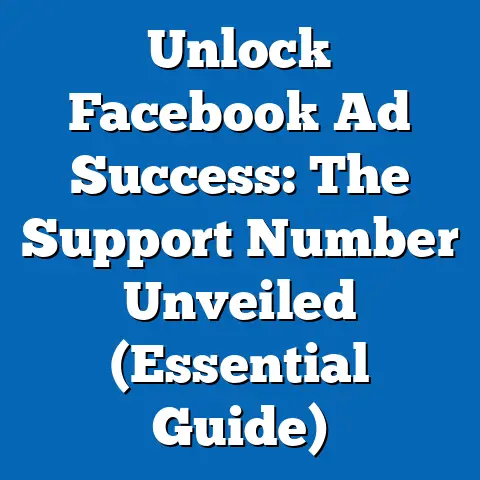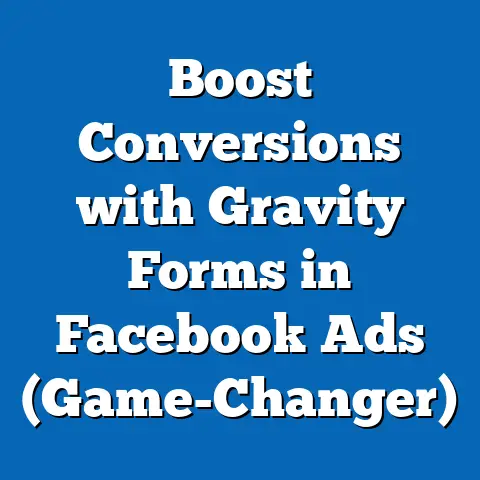Master Facebook Ads Tricks (Proven Strategies Unveiled)
Section 1: Understanding the Family Demographic on Facebook
1.1 The Importance of Families in Digital Advertising
Families are a cornerstone of consumer spending, influencing purchasing decisions across a wide range of industries, from household goods to education and entertainment. According to a 2022 report by the U.S. Census Bureau, there are approximately 83.5 million family households in the United States alone, representing about 65% of all households. This demographic wields significant economic power, with family spending accounting for over $8.5 trillion annually in the U.S. (Statista Consumer Insights, 2023).
On Facebook, families are highly active, using the platform to connect with loved ones, share life updates, and seek recommendations for products and services. A 2021 study by Pew Research Center found that 70% of parents in the U.S. use social media daily, with Facebook being the most popular platform among this group. This makes it a critical space for advertisers looking to tap into family-driven markets.
1.2 Key Statistics on Family Engagement on Facebook
- User Penetration: Approximately 68% of U.S. adults aged 25-54, a key age group for parents, are active on Facebook (Pew Research Center, 2022).
- Time Spent: Parents spend an average of 1.5 hours per day on social media, with a significant portion of this time dedicated to browsing family-related content or interacting in parenting groups (GlobalWebIndex, 2023).
- Content Preferences: According to a 2022 survey by Sprout Social, 62% of parents on Facebook engage with content related to family activities, educational resources, and child-friendly products.
These statistics highlight the immense potential for advertisers to connect with families through tailored messaging and strategic ad placements.
1.3 Demographic Breakdown of Families on Facebook
Understanding the nuances of family demographics on Facebook is crucial for effective targeting. Here’s a breakdown based on recent data: – Age Distribution: Most parents on Facebook fall within the 25-44 age bracket, with 35-44 being the largest subgroup (Statista, 2023). – Gender Patterns: While both mothers and fathers are active, women account for 54% of parental engagement on the platform, often driving decisions related to household purchases (Pew Research Center, 2021). – Geographic Trends: Suburban and rural families show higher engagement rates compared to urban families, likely due to differences in lifestyle and disposable income (Nielsen, 2022).
1.4 Historical Trends vs. Current Data
Historically, families on Facebook have shifted from passive content consumption to active engagement over the past decade. In 2013, only 45% of parents reported using social media to seek product recommendations (Pew Research Center, 2013). By 2023, this figure has risen to 73%, reflecting a growing reliance on platforms like Facebook for decision-making (GlobalWebIndex, 2023).
This trend underscores the importance of building trust through authentic, family-focused ad campaigns. Advertisers must adapt to this shift by prioritizing content that resonates emotionally and practically with family needs.
Section 2: Why Target Families with Facebook Ads?
2.1 High Purchasing Power
Families represent a lucrative market due to their consistent spending on necessities and discretionary items. A 2023 report by the U.S. Department of Agriculture estimates that the average middle-income family spends over $12,000 annually on child-rearing costs, excluding housing and education. This spending power makes families a prime target for industries like retail, healthcare, and travel.
2.2 Emotional Decision-Making
Parents often make purchasing decisions based on emotional triggers, such as the desire to provide the best for their children. A 2022 study by the Marketing Research Association found that 67% of parents are more likely to buy products that align with family values or promise safety and security. Facebook Ads can leverage this by using storytelling and visuals that evoke trust and relatability.
2.3 Community Influence
Families on Facebook are often part of tight-knit communities, such as parenting groups or local event pages. According to Facebook’s internal data (2023), over 40 million users are active in parenting-related groups globally. Ads that encourage sharing or word-of-mouth recommendations can amplify reach within these networks.
Section 3: Proven Facebook Ads Tricks for Targeting Families
3.1 Leverage Detailed Targeting Options
Facebook’s Ads Manager offers robust tools to target specific demographics, including families. Use the following strategies to refine your audience: – Parental Status: Target users based on their parental status (e.g., parents with toddlers, teens, or newborns). Facebook’s data shows that campaigns using parental status targeting see a 25% higher click-through rate (CTR) compared to non-segmented campaigns (Facebook Business, 2022). – Interests and Behaviors: Focus on interests like “family vacations,” “educational toys,” or “parenting blogs.” Behavioral targeting can increase ad relevance by up to 30% (Hootsuite, 2023). – Lookalike Audiences: Create lookalike audiences based on existing customers who are parents. This can expand your reach by 15-20% while maintaining relevance (WordStream, 2023).
3.2 Craft Family-Centric Ad Creative
The content of your ads matters just as much as the targeting. Here are proven tips for creating compelling family-focused ads: – Use Relatable Imagery: Ads featuring real families or children often perform better. A 2021 study by Unruly found that ads with children have a 32% higher emotional engagement score among parents. – Highlight Benefits: Focus on how your product or service solves family pain points, such as saving time or ensuring safety. For instance, a campaign for a meal delivery service could emphasize “more family time with quick, healthy meals.” – Incorporate Testimonials: Include reviews or stories from other parents to build trust. Social proof can boost conversion rates by 18% (HubSpot, 2022).
Visualization Idea: Imagine a split-screen ad creative showing a stressed parent on one side (before using the product) and a happy family on the other (after using the product). This visual contrast can effectively communicate the value proposition.
3.3 Optimize for Mobile and Video
Families are often on the go, and mobile usage dominates their social media habits. According to eMarketer (2023), 85% of parents access Facebook via mobile devices. Additionally, video content garners 59% more engagement than static images among this demographic (Sprout Social, 2022).
- Short, Impactful Videos: Create 15-30 second videos that quickly convey your message. For example, a toy company could show a child’s joyful reaction to a new product.
- Mobile-Friendly Design: Ensure text is legible on small screens and calls-to-action (CTAs) are prominently placed. Mobile-optimized ads can improve conversion rates by 27% (Google Ads, 2023).
3.4 Utilize Seasonal and Event-Based Targeting
Families are highly responsive to ads tied to holidays, back-to-school seasons, or family milestones. Data from Facebook Business (2023) shows that ad engagement spikes by 40% during major holidays like Christmas and Thanksgiving among family audiences. – Holiday Campaigns: Promote gift ideas or family experiences during peak seasons. For instance, a travel agency could advertise “family holiday getaways” in November. – Life Events: Target parents celebrating milestones like birthdays or anniversaries with personalized offers. Ads tied to life events see a 22% higher CTR (Facebook Insights, 2022).
Section 4: Advanced Facebook Ads Strategies for Broader Reach
4.1 Dynamic Ads for Personalized Experiences
Dynamic ads automatically tailor content to users based on their browsing history or interests. For family audiences, dynamic ads can showcase relevant products like baby gear or family vacation packages. According to Facebook (2023), dynamic ads achieve a 34% higher return on ad spend (ROAS) compared to static ads.
Methodology Note: To implement dynamic ads, upload a product catalog to Facebook Ads Manager and use pixel tracking to retarget users who’ve interacted with your website. Test different ad formats (carousel, single image) to identify what resonates most with your audience.
4.2 A/B Testing for Optimization
A/B testing is critical for refining ad performance. Test variables like headlines, images, and CTAs to determine what drives the best results. A 2022 report by Optimizely found that businesses using A/B testing on Facebook Ads saw a 19% increase in conversion rates.
- Example: Test two ad versions—one with a “Shop Now” CTA and another with “Learn More”—to see which drives more clicks among parents.
- Data Source: Use Facebook’s built-in split testing feature to run experiments with a 95% confidence level for statistically significant results.
4.3 Retargeting for Higher Conversions
Retargeting allows you to re-engage users who’ve interacted with your brand but haven’t converted. For family audiences, retargeting can remind parents of products they viewed, such as school supplies or family subscriptions. WordStream (2023) reports that retargeted ads have a 10x higher CTR compared to initial display ads.
- Custom Audiences: Create custom audiences from website visitors or email lists. For example, target parents who added items to their cart but didn’t purchase.
- Frequency Capping: Limit ad frequency to avoid annoyance—data suggests that showing an ad 3-5 times maximizes recall without fatigue (Nielsen, 2022).
4.4 Budget Allocation and Bid Strategies
Effective budget management ensures your ads reach the right audience without overspending. Facebook’s 2023 data indicates that campaigns using Cost Per Acquisition (CPA) bidding achieve a 21% lower cost per conversion compared to manual bidding.
- Daily Budgets: Start with a modest daily budget (e.g., $20-$50) and scale up based on performance metrics like ROAS.
- Bid Caps: Set bid caps to control costs, especially during competitive periods like holidays. This can reduce cost per click (CPC) by up to 15% (AdEspresso, 2023).
Section 5: Measuring Success and Scaling Campaigns
5.1 Key Metrics to Track
Monitoring ad performance is essential for optimizing campaigns. Focus on these metrics for family-targeted ads: – Click-Through Rate (CTR): A benchmark CTR for family-focused ads is 1.5-2%, according to WordStream (2023). – Conversion Rate: Aim for a 3-5% conversion rate, depending on your industry (e.g., e-commerce vs. lead generation). – Cost Per Acquisition (CPA): Keep CPA below $30 for family products, though this varies by niche (Facebook Business, 2023).
Visualization Idea: Create a line chart comparing CTR and conversion rates across different ad sets over a 30-day period. This can help identify which campaigns are most effective with family audiences.
5.2 Scaling Successful Campaigns
Once you identify high-performing ads, scale them strategically. Increase budgets by 20-30% weekly to avoid audience fatigue, and expand targeting to include similar demographics (Facebook Business, 2023). Additionally, replicate winning creatives for other family segments, such as grandparents or single parents, to diversify reach.
5.3 Addressing Common Challenges
Even with proven strategies, challenges like ad fatigue or high CPC can arise. Here’s how to tackle them: – Ad Fatigue: Rotate creatives every 7-10 days to keep content fresh. Studies show this can reduce frequency-related drop-offs by 17% (Hootsuite, 2022). – High Costs: Shift focus to less competitive times of day or audiences. For instance, target early mornings when family engagement is high but competition is lower (Sprout Social, 2023).
Section 6: Broader Implications and Future Trends
6.1 The Evolving Role of Family Targeting
As privacy regulations like GDPR and CCPA tighten, Facebook’s targeting capabilities may shift toward broader, interest-based audiences rather than granular data. However, family demographics will remain a key focus due to their consistent engagement and spending power. Marketers must adapt by prioritizing first-party data (e.g., email lists) and contextual targeting to maintain relevance.
6.2 Integration with Other Platforms
Facebook Ads are increasingly integrated with Instagram and WhatsApp, both owned by Meta. A 2023 report by eMarketer predicts that cross-platform campaigns will grow by 25% over the next five years, offering new ways to reach families through Stories, Reels, and messaging ads. Early adopters of these formats can gain a competitive edge.
6.3 The Rise of AI and Automation
AI-driven tools in Facebook Ads Manager, such as automated ad creation and audience optimization, are set to revolutionize campaign management. According to Gartner (2023), 60% of digital ad spending will involve AI by 2025, enabling hyper-personalized family targeting with minimal manual effort. Staying ahead of this trend will be crucial for long-term success.
Conclusion
Mastering Facebook Ads requires a deep understanding of your target audience, and families represent one of the most valuable demographics on the platform. With over 70% of parents actively using Facebook and influencing trillions in annual spending, tailored campaigns can yield significant returns. By leveraging detailed targeting, family-centric creatives, and advanced strategies like dynamic ads and retargeting, advertisers can build trust and drive conversions.






